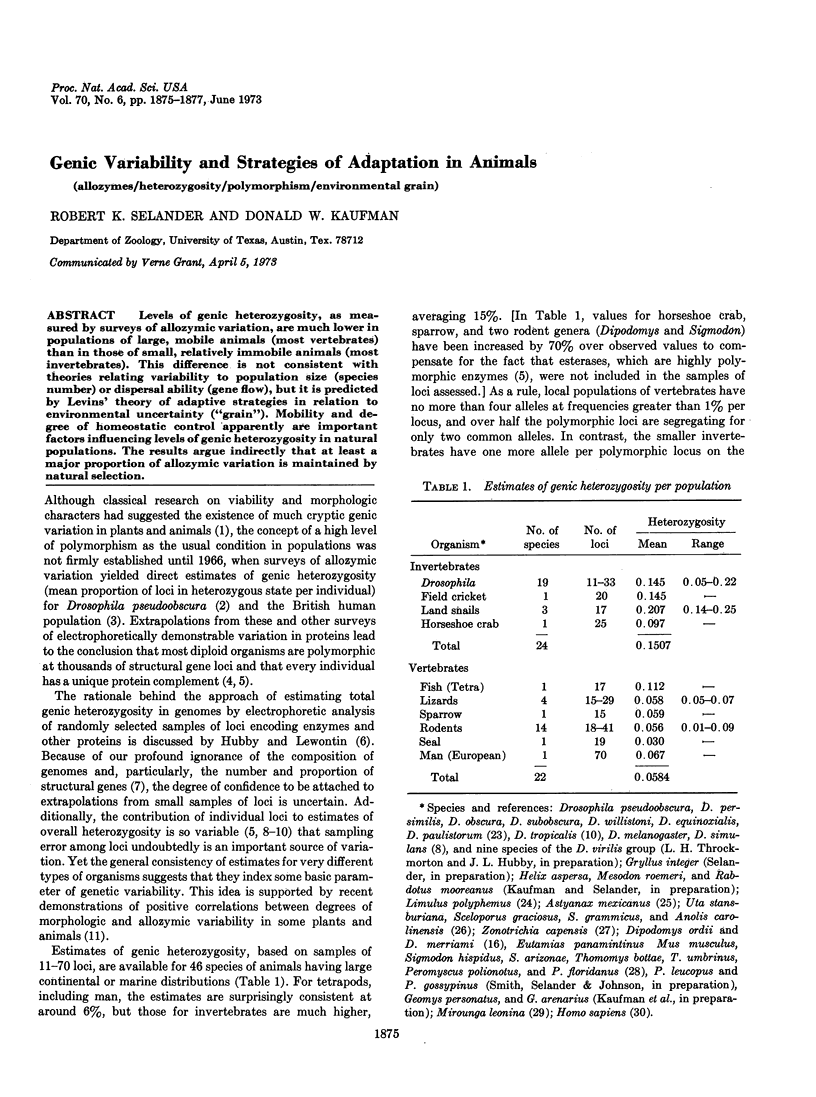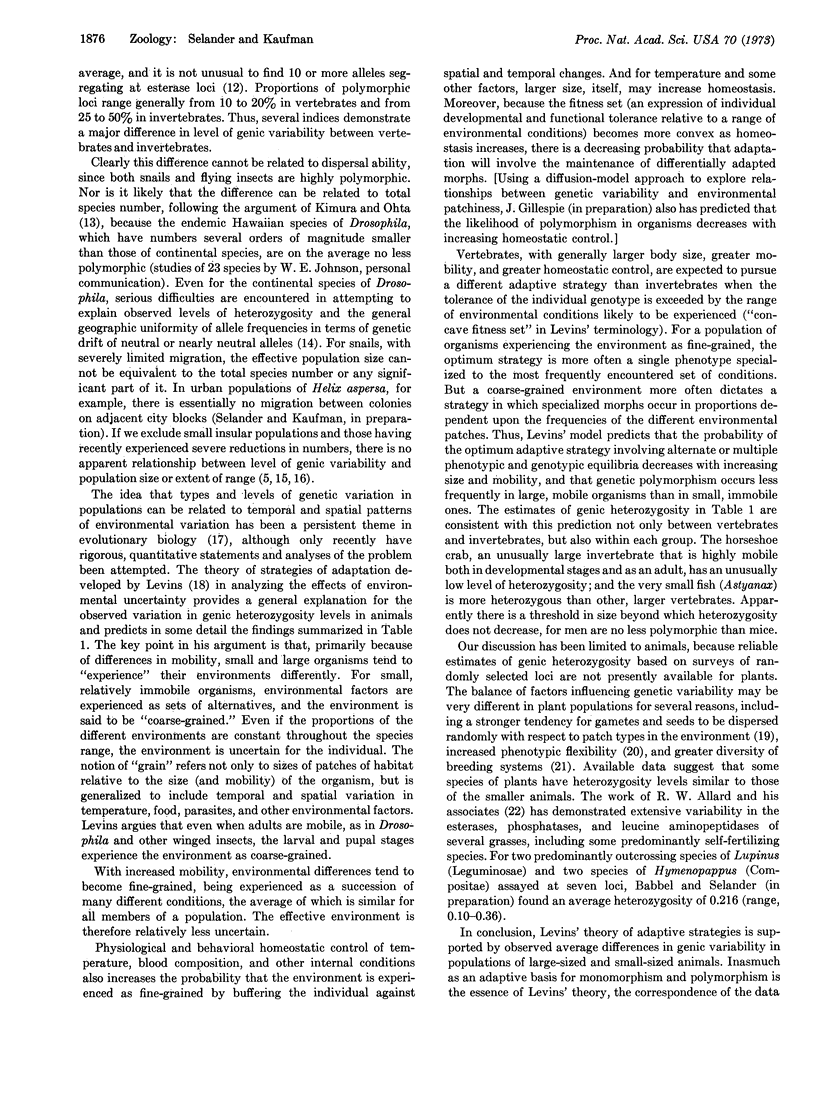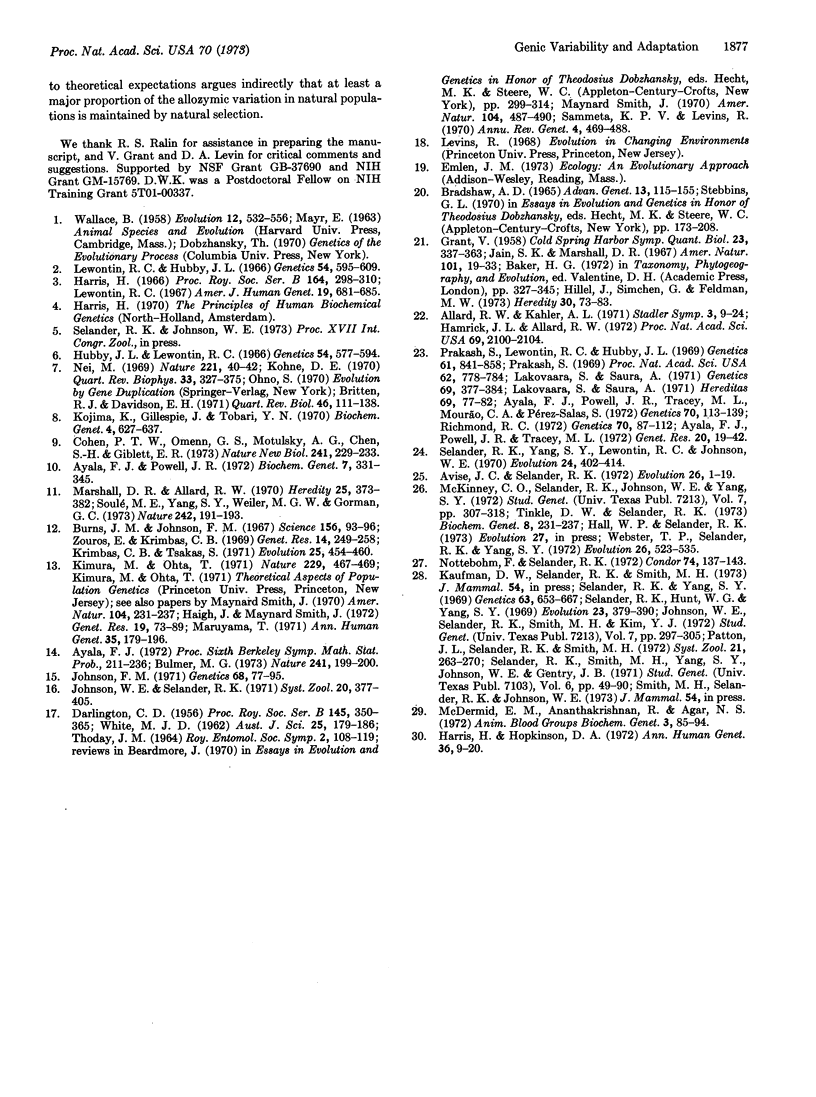Abstract
Levels of genic heterozygosity, as measured by surveys of allozymic variation, are much lower in populations of large, mobile animals (most vertebrates) than in those of small, relatively immobile animals (most invertebrates). This difference is not consistent with theories relating variability to population size (species number) or dispersal ability (gene flow), but it is predicted by Levins' theory of adaptive strategies in relation to environmental uncertainty (“grain”). Mobility and degree of homeostatic control apparently are important factors influencing levels of genic heterozygosity in natural populations. The results argue indirectly that at least a major proportion of allozymic variation is maintained by natural selection.
Keywords: allozymes, heterozygosity, polymorphism, environmental grain
Full text
PDF


Selected References
These references are in PubMed. This may not be the complete list of references from this article.
- Ayala F. J., Powell J. R. Enzyme variability in the Drosophila willistoni group. VI. Levels of polymorphism and the physiological function of enzymes. Biochem Genet. 1972 Dec;7(3):331–345. doi: 10.1007/BF00484832. [DOI] [PubMed] [Google Scholar]
- Ayala F. J., Powell J. R., Tracey M. L. Enzyme variability in the Drosophila Willistoni group. V. Genic variation in natural populations of Drosophila equinoxialis. Genet Res. 1972 Aug;20(1):19–42. doi: 10.1017/s0016672300013562. [DOI] [PubMed] [Google Scholar]
- Ayala F. J., Powell J. R., Tracey M. L., Mourão C. A., Pérez-Salas S. Enzyme variability in the Drosophila willistoni group. IV. Genic variation in natural populations of Drosophila willistoni. Genetics. 1972 Jan;70(1):113–139. doi: 10.1093/genetics/70.1.113. [DOI] [PMC free article] [PubMed] [Google Scholar]
- Britten R. J., Davidson E. H. Repetitive and non-repetitive DNA sequences and a speculation on the origins of evolutionary novelty. Q Rev Biol. 1971 Jun;46(2):111–138. doi: 10.1086/406830. [DOI] [PubMed] [Google Scholar]
- Bulmer M. G. Geographical uniformity of protein polymorphisms. Nature. 1973 Jan 19;241(5386):199–200. doi: 10.1038/241199a0. [DOI] [PubMed] [Google Scholar]
- Burns J. M., Johnson F. M. Esterase polymorphism in natural populations of a sulfur butterfly, Colias eurytheme. Science. 1967 Apr 7;156(3771):93–96. doi: 10.1126/science.156.3771.93. [DOI] [PubMed] [Google Scholar]
- Cohen P. T., Omenn G. S., Motulsky A. G., Chen S. H., Giblett E. R. Restricted variation in the glycolytic enzymes of human brain and erythrocytes. Nat New Biol. 1973 Feb 21;241(112):229–233. doi: 10.1038/newbio241229a0. [DOI] [PubMed] [Google Scholar]
- DARLINGTON C. D. Natural populations and the breakdown of classical genetics. Proc R Soc Lond B Biol Sci. 1956 Jul 24;145(920):350–364. doi: 10.1098/rspb.1956.0048. [DOI] [PubMed] [Google Scholar]
- GRANT V. The regulation of recombination in plants. Cold Spring Harb Symp Quant Biol. 1958;23:337–363. doi: 10.1101/sqb.1958.023.01.034. [DOI] [PubMed] [Google Scholar]
- Haigh J., Smith J. M. Population size and protein variation in man. Genet Res. 1972 Feb;19(1):73–89. doi: 10.1017/s0016672300014282. [DOI] [PubMed] [Google Scholar]
- Hamrick J. L., Allard R. W. Microgeographical Variation in Allozyme Frequencies in Avena barbata. Proc Natl Acad Sci U S A. 1972 Aug;69(8):2100–2104. doi: 10.1073/pnas.69.8.2100. [DOI] [PMC free article] [PubMed] [Google Scholar]
- Harris H. Enzyme polymorphisms in man. Proc R Soc Lond B Biol Sci. 1966 Mar 22;164(995):298–310. doi: 10.1098/rspb.1966.0032. [DOI] [PubMed] [Google Scholar]
- Harris H., Hopkinson D. A. Average heterozygosity per locus in man: an estimate based on the incidence of enzyme polymorphisms. Ann Hum Genet. 1972 Jul;36(1):9–20. doi: 10.1111/j.1469-1809.1972.tb00578.x. [DOI] [PubMed] [Google Scholar]
- Hubby J. L., Lewontin R. C. A molecular approach to the study of genic heterozygosity in natural populations. I. The number of alleles at different loci in Drosophila pseudoobscura. Genetics. 1966 Aug;54(2):577–594. doi: 10.1093/genetics/54.2.577. [DOI] [PMC free article] [PubMed] [Google Scholar]
- Johnson F. M. Isozyme Polymorphisms in DROSOPHILA ANANASSAE: Genetic Diversity among Island Populations in the South Pacific. Genetics. 1971 May;68(1):77–95. doi: 10.1093/genetics/68.1.77. [DOI] [PMC free article] [PubMed] [Google Scholar]
- Kimura M., Ohta T. Protein polymorphism as a phase of molecular evolution. Nature. 1971 Feb 12;229(5285):467–469. doi: 10.1038/229467a0. [DOI] [PubMed] [Google Scholar]
- Kojima K., Gillespie J., Toari Y. N. A profile of Drosophila species' enzymes assayed by electrophoresis. I. Number of alleles, heterozygosities, and linkage disequilibrium in glucose-metabolizing systems and some other enzymes. Biochem Genet. 1970 Oct;4(5):627–637. doi: 10.1007/BF00486100. [DOI] [PubMed] [Google Scholar]
- Lakovaara S., Saura A. Genetic variation in natural populations of Drosophila obscura. Genetics. 1971 Nov;69(3):377–384. doi: 10.1093/genetics/69.3.377. [DOI] [PMC free article] [PubMed] [Google Scholar]
- Lakovaara S., Saura A. Genic variation in marginal populations of Drosophila subobscura. Hereditas. 1971;69(1):77–82. doi: 10.1111/j.1601-5223.1971.tb02420.x. [DOI] [PubMed] [Google Scholar]
- Lewontin R. C. An estimate of average heterozygosity in man. Am J Hum Genet. 1967 Sep;19(5):681–685. [PMC free article] [PubMed] [Google Scholar]
- Lewontin R. C., Hubby J. L. A molecular approach to the study of genic heterozygosity in natural populations. II. Amount of variation and degree of heterozygosity in natural populations of Drosophila pseudoobscura. Genetics. 1966 Aug;54(2):595–609. doi: 10.1093/genetics/54.2.595. [DOI] [PMC free article] [PubMed] [Google Scholar]
- Maruyama T. Analysis of population structure. II. Two-dimensional stepping stone models of finite length and other geographically structured populations. Ann Hum Genet. 1971 Oct;35(2):179–196. doi: 10.1111/j.1469-1809.1956.tb01391.x. [DOI] [PubMed] [Google Scholar]
- Nei M. Gene duplication and nucleotide substitution in evolution. Nature. 1969 Jan 4;221(5175):40–42. doi: 10.1038/221040a0. [DOI] [PubMed] [Google Scholar]
- Prakash S. Genic variation in a natural population of Drosophila persimilis. Proc Natl Acad Sci U S A. 1969 Mar;62(3):778–784. doi: 10.1073/pnas.62.3.778. [DOI] [PMC free article] [PubMed] [Google Scholar]
- Prakash S., Lewontin R. C., Hubby J. L. A molecular approach to the study of genic heterozygosity in natural populations. IV. Patterns of genic variation in central, marginal and isolated populations of Drosophila pseudoobscura. Genetics. 1969 Apr;61(4):841–858. doi: 10.1093/genetics/61.4.841. [DOI] [PMC free article] [PubMed] [Google Scholar]
- REV K., REV L., LEHOCZKY G. A portio laphámrákjának alkalias phosphatase aktivitása és annak változása a radium gamma-sugarainak hátására. Kiserl Orvostud. 1952 Dec;4(6):469–474. [PubMed] [Google Scholar]
- Richmond R. C. Enzyme variability in the Drosophila willistoni group. 3. Amounts of variability in the superspecies, D. paulistorum. Genetics. 1972 Jan;70(1):87–112. doi: 10.1093/genetics/70.1.87. [DOI] [PMC free article] [PubMed] [Google Scholar]
- Sammeta K. P., Levins R. Genetics and ecology. Annu Rev Genet. 1970;4:469–488. doi: 10.1146/annurev.ge.04.120170.002345. [DOI] [PubMed] [Google Scholar]
- Selander R. K., Yang S. Y. Protein polymorphism and genic heterozygosity in a wild population of the house mouse (Mus musculus). Genetics. 1969 Nov;63(3):653–667. doi: 10.1093/genetics/63.3.653. [DOI] [PMC free article] [PubMed] [Google Scholar]
- Tinkle D. W., Selander R. K. Age-dependent allozymic variation in a natural population of lizards. Biochem Genet. 1973 Mar;8(3):231–237. doi: 10.1007/BF00486175. [DOI] [PubMed] [Google Scholar]
- Zouros E., Krimbas C. B. The genetics of Dacus oleae. 3. Amount of variation at two esterase loci in a Greek population. Genet Res. 1969 Dec;14(3):249–258. doi: 10.1017/s0016672300002081. [DOI] [PubMed] [Google Scholar]


